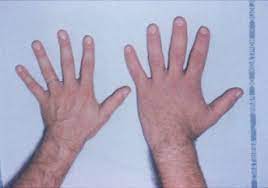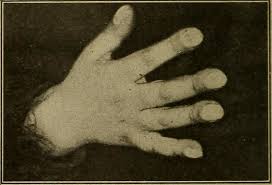The Facts About Acromegaly
The Facts About Acromegaly
Acromegaly is a medical condition that is caused by the excessive release of Human Growth Hormone by the pituitary or by a tumor. The pituitary gland is a tiny gland that rests just behind the eyes underneath the brain.
The pituitary gland is often referred to as the Master Gland because of the various functions that the pituitary gland controls, including reproductive  function, metabolism, and growth.
function, metabolism, and growth.
What Causes Acromegaly?
The vast majority of patients with Acromegaly experience the condition as a result of a benign tumor attached to the pituitary gland, which imitates the activity of the Somatotrophs, which are responsible for the release of Natural Growth Hormone.
Excess HGH production over the course of a long period of time causes the body to grow abnormally. It causes the bones and cartilage in the feet, hands, and face to grow abnormally long and thick. Pituitary tumors that cause acromegaly can also lead to migraines because of increased brain pressure or pressure on the optic nerve.
How Do Hormones Contribute to Acromegaly?
Acromegaly affects the production and activity of three particular hormones that are very important and all related to the somatotrophs. These are the hormones that are primarily affected by acromegaly:
Human Growth Hormone - Normally, the human body produces HGH throughout the day, in short bursts known as pulses. The hormone is primarily released during deep sleep and
intense physical activity. When the body produces too much HGH, it impacts the growth of organs and systems all throughout the body and can impact physical appearance.
Insulin-like Growth Factor-One - The release of this hormone is directly influenced by the release of Human Growth Hormone. HGH circulates through the body, and much of it is processed by the liver into IGF-1. IGF-1 remains active more constantly than Human Growth Hormone, and many symptoms of Acromegaly are caused by a simultaneous rise in these two hormones.
Somatostatins - These hormones are essential in Growth Hormone and IGF-1 regulation. Under normal circumstances, the human body recognizes the influx of HGH and IGF-1, and the brain releases somatostatins in response to mitigate the release of HGH by the pituitary. Somatostatin Therapy plays an essential role in the treatment of Acromegaly.
What are the Symptoms of Acromegaly?
Acromegaly is a complex disorder that affects both health and appearance. Many people don't realize that they have been suffering from Acromegaly for many years because the effects come slowly and can often be difficult to notice until the symptoms are already problematic.
Often, acromegaly symptoms are written off simply as aging by the patient, and many conditions can imitate some of the symptoms of the condition.
Acromegaly often doesn't become clearly noticeable for many years.
It is essential to understand that although there are many signs and symptoms, most patients only experience a few symptoms. Below are the symptoms that are associated with Acromegaly:
Sleep Apnea
Diabetes
Cardiovascular Issues
Hypertension
Vision Changes due to Tumor Growth
Migraines
Cartilage swelling
Increased Size of Internal Organs
Increased size of Feet, Hands, and Jaw
Joint Swelling and Pain
Sweating
Acne, Increased Oil Production, Thicker Skin, and other Skin Issues
Nasal Congestion
Goiter
Impotence
Menstrual Disruption
Skin Tags
Carpal Tunnel Syndrome
How is Acromegaly Diagnosed?
There are a number of tests that can effectively diagnose and keep track of Acromegaly. The most effective blood test for Acromegaly is Growth Hormone Analysis.
Typically, HGH Levels spike and remain in the bloodstream for only a brief period of time. Still, in the case of Acromegaly, Growth Hormone Levels remain excessively high or reach abnormally high spikes.
Natural HGH Secretions are dependent upon a number of different variables, including when the test is taken, age, and genetics, as well as the last time that you ate. The following are the principal means by which Growth Hormone Levels are Tested:
that you ate. The following are the principal means by which Growth Hormone Levels are Tested:
Oral Glucose Tolerance Test - The easiest way to analyze Growth Hormone Levels through a single test is for the patient to fast for a single night and provide blood after drinking a specialized solution of glucose concentration.
IGF-1 Testing - One can also test for Acromegaly by testing IGF-1, which is released directly in response to Growth Hormone Secretion. IGF-1 is a byproduct of Acromegaly, and it is exceedingly rare that IGF-1 Levels do not increase to abnormally high levels due to Acromegaly. IGF-1 Levels can also be easily tested because they don't spike like HGH Levels.
Acromegaly Imaging Tests for Tumor Identification
Once the case for Acromegaly has been established, the physician recommends imaging scans to identify the tumor. This can be completed using a CT Scan or an MRI.
These tests provide a high-resolution image of the brain, which can be monitored for tumors or other abnormalities. These Imaging Scans are outpatient procedures that do not require any patient preparation.
Health Tests Performed After Acromegaly Diagnosis
After Acromegaly has been diagnosed via HGH/IGF-1 Levels and visual confirmation on the tumor, other tests will be necessary to assess the patient's health. Patients will usually undergo vision testing, chest X-Ray, and ECG to monitor the extent to which Acromegaly has affected their health.
None of these tests require a stay at a hospital, and none of these tests even necessarily require a trip to the hospital, though they may be performed at one.
The technicians and specialists that perform these tests will forward the results directly to your primary care physician, who will explain the results in detail and use all of the information available to inform you of your current condition and what steps can be taken to improve your health.
Why Is It Important to Control and Treat Acromegaly
Until the tumor is surgically or medically removed, the condition is chronic, but proper treatment can cancel out the health modulating effects of the tumor. You can improve your health significantly and significantly reduce the risks associated with the condition through proper treatment.
Most patients begin treatment almost immediately after receiving a diagnosis. Your healthcare provider can take steps to control the various factors at play concerning Acromegaly, including controlling IGF-1 Levels and HGH Levels, treating the disorder's symptoms, and treating the tumor itself.
Medical Conditions Associated with Acromegaly
Part of effectively treating Acromegaly is being aware of the increased risk of a number of different disorders and treating them accordingly. These conditions include:
Colon Cancer and Colon Polyps
Sleep Apnea
Diabetes
Cardiovascular Disease
Hypertension
Take Control of Your Acromegaly Treatment to Maximize Health Outcomes
It's vitally important to maintain awareness of your Growth Hormone and Insulin-Like Growth Factor-One Levels to treat your condition effectively. Your physician will provide you with somatostatins and other medical treatments designed to treat your hyperpituitarism and the medical conditions related to the disorder.
Every day you go untreated, your health becomes that much more at risk. If you get treatment quickly enough, you can even reverse or at least mitigate some of the symptoms, including Hypertension, Sleep Apnea, Fatigue, Joint Pain, Sweating, Cartilage Swelling, and Headache.
Acromegaly Treatment Options
The most effective way to treat Acromegaly is by taking steps to get rid of the tumor. Some treatments can reduce the activity of the tumor until you can get access to treatment that will eliminate it.
Surgery for Acromegaly - Surgery is the most direct way to treat a Pituitary Somatotroph Tumor. Because the pituitary is located beneath the brain, it is often possible to remove the tumor with minimal risk and, in doing so, return IGF-1 and Growth Hormone Levels to normal, as well as eliminate Intracranial Hypertension.
This can be achieved through a method known as transsphenoidal surgery. In this procedure, the surgeon enters the brain cavity through the upper lip or nose and removes the tumor without opening the skull.
Radiation Treatment for Acromegaly - This form of treatment is paired with surgery in the instance that the pituitary tumor is not obliterated and
 prescription medications are not effectively eliminating the remains of the tumor.
prescription medications are not effectively eliminating the remains of the tumor.
Prescription Acromegaly Treatment - There are a number of medications that can suppress the Pituitary's ability to produce Human Growth Hormone before surgery and also help eliminate any tumor remnants that are not entirely eliminated through surgery.
Acromegaly and Human Growth Hormone
Acromegaly is a Pituitary Condition
Even though HGH Abuse can lead to symptoms usually associated with Acromegaly, it is essential to point out that Acromegaly is a specific medical disorder caused by a tumor on the pituitary gland.
Although long-term abuse of Human Growth Hormone can lead to symptoms similar to Acromegaly, the two conditions are unique to one another.
Can HGH Injection Therapy lead to Acromegaly?
No. The goal of Human Growth Hormone Injections is to restore optimal, youthful HGH and IGF-1 Levels in the bloodstream, not to introduce more of the hormones the body can handle healthily. Acromegaly-like symptoms result from a long-term flood of Human Growth Hormone and cannot be triggered by Restorative Doses of HGH.
HGH Abuse and Overdose Does Not Lead to Acromegaly Symptoms for a Long Period of Time
Also, like the condition of Acromegaly itself, it can take years of excess HGH and IGF-1 Levels before it becomes physically apparent that the patient is suffering from such a condition, whether it is from the disease of Acromegaly or the decision to abuse Bio-Identical HGH.
Suppose a patient does begin to show Acromegaly-like symptoms, such as joint stiffness, carpal tunnel syndrome, or increased soft tissue production. In that case, there is still time to mitigate or prevent long-term damage to physiological health by suspending Injectable Growth Hormone Abuse.
Famous People with Acromegaly
Today, Acromegaly is recognized more quickly than it was in the past and treated more promptly. Still, over the last fifty years, many celebrities have been known for having Acromegaly, the most famous of which is Andre the Giant.
Andre the Giant was 7 foot 4 inches and weighed as much as 520 pounds. He first reached celebrity status as a star of the World Wrestling Federation and later had a notable acting career, starring in films such as The Princess Bride and Conan the Destroyer.
Although he was primarily seen as a beloved character, he dealt with immense pain from his condition, leading him to alcoholism. Despite his propensity for drinking and his wrestling persona, he was widely regarded as an incredibly kind and gentle person.
Other Celebrities with Acromegaly:
WWE star Big Show, also known as Paul Randall Wight, Junior
UFC Fighter Antonio Silva
Richard Kiel, most famously known for his role as Jaws for the James Bond Franchise
Carel Struycken, who starred as Lurch in the Adams Family films
- What Is Adrenal Fatigue [Last Updated On: August 20th, 2024] [Originally Added On: October 23rd, 2020]
- Understanding Thyroid Function And Diagnosing Thyroid Issues [Last Updated On: August 21st, 2024] [Originally Added On: October 24th, 2020]
- Twelve Steps To Enhance And Preserve Your Memory [Last Updated On: January 28th, 2025] [Originally Added On: October 25th, 2020]
- The Psychological And Physiological Effects Of Serotonin [Last Updated On: January 28th, 2025] [Originally Added On: October 26th, 2020]
- The Facts About Psoriasis: Symptoms And Causes [Last Updated On: January 27th, 2025] [Originally Added On: October 27th, 2020]
- The Effects Of Hgh Deficiency Upon One Of A Pair Of Twins [Last Updated On: January 27th, 2025] [Originally Added On: October 29th, 2020]
- Resveratrol Anti-aging Supplementation For Longevity [Last Updated On: August 19th, 2024] [Originally Added On: October 30th, 2020]
- Sermorelin Acetate Injections With Ghrp-6 [Last Updated On: February 18th, 2025] [Originally Added On: October 31st, 2020]
- Melatonin The Sleep Hormone How It Impacts Your Health [Last Updated On: August 26th, 2024] [Originally Added On: November 1st, 2020]
- Mark Cuban To Fund Study On Healing Power Of Hgh [Last Updated On: August 27th, 2024] [Originally Added On: November 2nd, 2020]
- Mark Cuban Advocates For Hgh As A Rehab And Recovery Tool [Last Updated On: January 26th, 2025] [Originally Added On: November 3rd, 2020]
- Leptin Hormone Guide: The Effects Of The Satiety Hormone [Last Updated On: January 26th, 2025] [Originally Added On: November 4th, 2020]
- Human Growth Hormone Deficiency Impact On Sleeping Habits [Last Updated On: January 25th, 2025] [Originally Added On: November 5th, 2020]
- Human Growth Hormone And Liver Regeneration [Last Updated On: January 25th, 2025] [Originally Added On: November 6th, 2020]
- Hgh Treatment For Fatty Liver Disease On The Horizon [Last Updated On: February 17th, 2025] [Originally Added On: November 7th, 2020]
- Your Current HGH Level [Last Updated On: June 27th, 2024] [Originally Added On: November 8th, 2020]
- Ghrelin The Hunger Hormone [Last Updated On: January 24th, 2025] [Originally Added On: November 9th, 2020]
- Enclomiphene Citrate Andropause Treatment Up For Fda Approval [Last Updated On: January 24th, 2025] [Originally Added On: November 10th, 2020]
- Dopamine Pleasure Hormone And So Much More [Last Updated On: July 27th, 2024] [Originally Added On: November 11th, 2020]
- Diabetes Cure On The Horizon [Last Updated On: January 23rd, 2025] [Originally Added On: November 12th, 2020]
- Boost Metabolism To Lose Weight And Maintain Weight Loss [Last Updated On: January 23rd, 2025] [Originally Added On: November 13th, 2020]
- Andropause A Mid-life Hormone Crisis [Last Updated On: February 18th, 2025] [Originally Added On: November 14th, 2020]
- SOGROYA INJECTIONS FOR HUMAN GROWTH HORMONE DEFICIENCY [Last Updated On: February 19th, 2025] [Originally Added On: March 24th, 2021]
- How Do High and Low Estrogen Impact Male Health and Wellness? [Last Updated On: February 9th, 2025] [Originally Added On: April 2nd, 2021]
- The Effects Of Hormone Imbalance On Belly Fat [Last Updated On: February 18th, 2025] [Originally Added On: May 8th, 2021]
- Could Sunlight Help Remove Rogue Hormones from the Water Supply? [Last Updated On: February 20th, 2025] [Originally Added On: May 29th, 2021]
- Weekly HGH Therapy Just as Effective as Daily Injections [Last Updated On: July 5th, 2024] [Originally Added On: June 18th, 2021]
- DHEA and Testosterone: A winning team! [Last Updated On: February 14th, 2025] [Originally Added On: January 19th, 2022]
- Animal Research Discovers Link Between Exercise, HGH, and Cognitive Ability [Last Updated On: February 14th, 2025] [Originally Added On: May 20th, 2022]
- Weekly Hormone Treatments for Adult HGH Deficiency with Sogroya [Last Updated On: February 18th, 2025] [Originally Added On: June 14th, 2022]
- Ancient Critters Made Human Hormone System What It Is Today [Last Updated On: March 13th, 2025] [Originally Added On: June 26th, 2022]
- How Substance Abuse Can Affect Your Hormone Levels [Last Updated On: March 16th, 2025] [Originally Added On: August 4th, 2022]
- A Holistic Approach to Health and Water Safety [Last Updated On: February 7th, 2025] [Originally Added On: February 7th, 2025]
- Understanding the Role of Sogroya in Adult Human Growth Hormone (HGH) Deficiency Treatment [Last Updated On: February 12th, 2025] [Originally Added On: February 11th, 2025]
- Andropause: An Examination of Mid-life Hormonal Shifts in Males [Last Updated On: February 16th, 2025] [Originally Added On: February 13th, 2025]
- Sermorelin Acetate Therapy: A Comprehensive Insight into its Benefits with GHRP-6 [Last Updated On: February 17th, 2025] [Originally Added On: February 14th, 2025]
- The Dynamic Duo of Male Vitality: Testosterone and DHEA [Last Updated On: February 14th, 2025] [Originally Added On: February 14th, 2025]
Word Count: 1772







